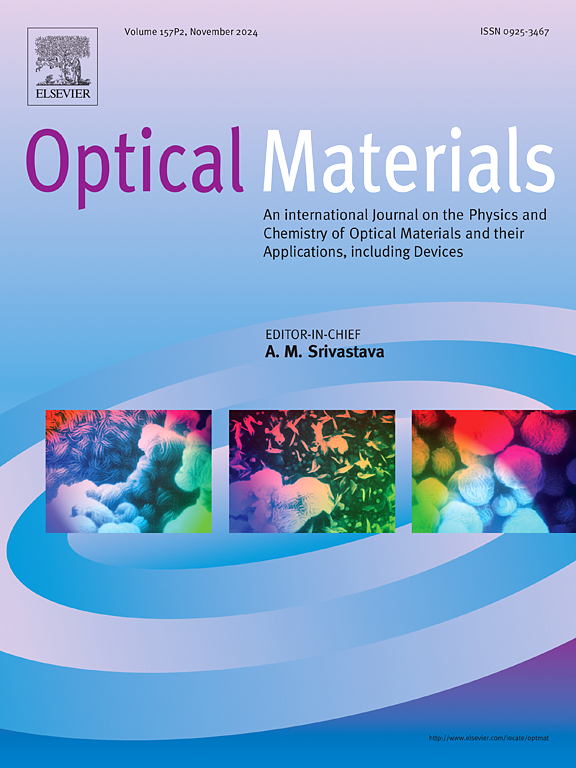Optimization of mechanoluminescence properties of ZnS:M@Al2O3-PDMS (M = Mn, Cu) composites based on synergistic effects of temperature and composition
IF 3.8
3区 材料科学
Q2 MATERIALS SCIENCE, MULTIDISCIPLINARY
引用次数: 0
Abstract
When ZnS:M@Al2O3 (M = Mn, Cu) is combined with PDMS, although it has a certain luminescence potential, due to its weak luminescence intensity, it is difficult for common spectral sensors on the market to effectively detect its luminescence signal, and it must be detected by precision instruments and devices with high sensitivity, which is particularly prominent in the fields of flexible electronics and intelligent sensing. This study systematically investigates the synergistic effects of temperature (60–90 °C) and composition ratio (2:8 to7:3) on the mechanoluminescence performance of ZnS:M@Al2O3-PDMS composites (M = Mn, Cu). RGB analysis and spectral characterization showed that low temperature (60 °C) and moderate to high ZnS:M@Al2O3 content enhanced the luminescence intensity. However, excessive particles and high temperature (90 °C) degrade the luminescence performance due to an increase in Young's modulus and aggregation. Mechanistic studies indicate that PDMS with a low Young's modulus (2.679–3.393 MPa) at 60 °C facilitates stress transfer and internal electric field enhancement in ZnS particles, optimizing electron-hole recombination. The application successfully demonstrated its potential in motion monitoring and interactive display of pressure response for self-powered soft robots, laying the foundation for the further development and application of ML materials.
基于温度和成分协同效应的ZnS:M@Al2O3-PDMS (M = Mn, Cu)复合材料机械发光性能优化
当ZnS:M@Al2O3 (M = Mn, Cu)与PDMS结合时,虽然具有一定的发光电位,但由于其发光强度较弱,市场上常见的光谱传感器很难有效检测到其发光信号,必须通过高灵敏度的精密仪器和设备进行检测,这在柔性电子和智能传感领域尤为突出。本文系统研究了温度(60 ~ 90℃)和配比(2:8 ~ 7:3)对ZnS:M@Al2O3-PDMS复合材料(M = Mn, Cu)机械发光性能的协同效应。RGB分析和光谱表征表明,低温(60℃)和中至高ZnS:M@Al2O3含量增强了发光强度。然而,过量的颗粒和高温(90℃)会导致杨氏模量和聚集量的增加,从而降低发光性能。机制研究表明,60℃时低杨氏模量(2.679 ~ 3.393 MPa)的PDMS有利于ZnS颗粒的应力传递和内部电场增强,优化了电子-空穴复合。该应用成功展示了其在自供电软机器人运动监测和压力响应交互显示方面的潜力,为ML材料的进一步开发和应用奠定了基础。
本文章由计算机程序翻译,如有差异,请以英文原文为准。
求助全文
约1分钟内获得全文
求助全文
来源期刊

Optical Materials
工程技术-材料科学:综合
CiteScore
6.60
自引率
12.80%
发文量
1265
审稿时长
38 days
期刊介绍:
Optical Materials has an open access mirror journal Optical Materials: X, sharing the same aims and scope, editorial team, submission system and rigorous peer review.
The purpose of Optical Materials is to provide a means of communication and technology transfer between researchers who are interested in materials for potential device applications. The journal publishes original papers and review articles on the design, synthesis, characterisation and applications of optical materials.
OPTICAL MATERIALS focuses on:
• Optical Properties of Material Systems;
• The Materials Aspects of Optical Phenomena;
• The Materials Aspects of Devices and Applications.
Authors can submit separate research elements describing their data to Data in Brief and methods to Methods X.
 求助内容:
求助内容: 应助结果提醒方式:
应助结果提醒方式:


